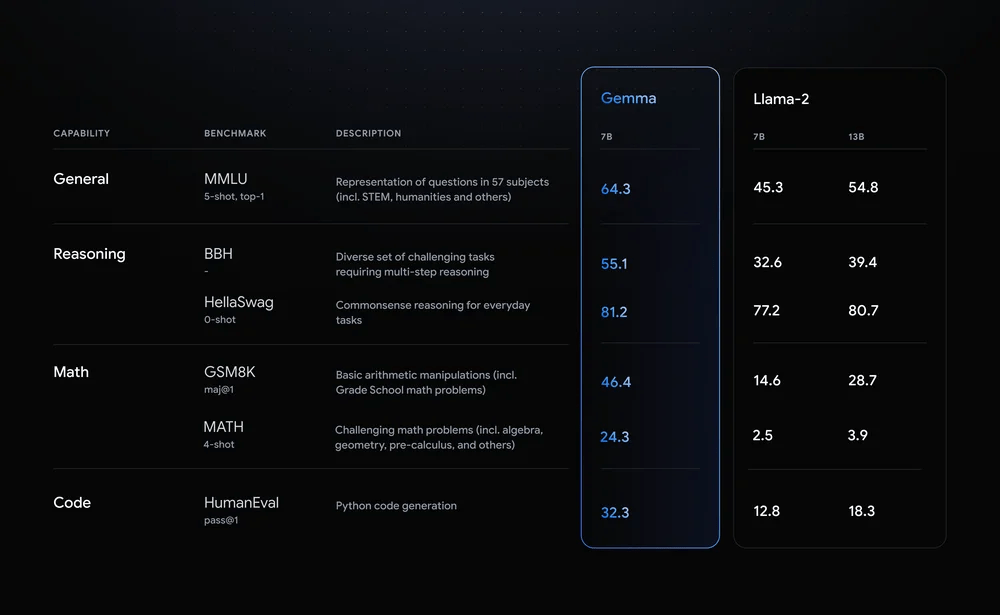Google has always been at the forefront of AI innovation, and with Gemma, they’re once again raising the bar. Gemma is a family of open models designed to assist developers and researchers in building AI applications responsibly and effectively. In this article, we’ll delve into the key features of Gemma models, their performance, responsible design principles, compatibility, and how developers can get started with them.
Key Features of Gemma Models

– Model Sizes and Variants
Gemma comes in two sizes: Gemma 2B and Gemma 7B. Each size offers pre-trained and instruction-tuned variants, catering to different application needs and computational resources.
– Responsible Generative AI Toolkit
To ensure the responsible use of Gemma models, Google provides a comprehensive toolkit. This toolkit includes guidance and tools for building safer AI applications, such as safety classification methodologies and model debugging tools.
– Toolchains and Integration
Developers can leverage Gemma models across major frameworks like JAX, PyTorch, and TensorFlow through native Keras 3.0. Additionally, ready-to-use Colab and Kaggle notebooks, along with integration with popular tools like Hugging Face, simplify the development process.
– Deployment Options
Gemma models can run on various platforms, including laptops, workstations, and Google Cloud. With easy deployment options on Vertex AI and Google Kubernetes Engine (GKE), developers can seamlessly deploy their AI applications.
Performance and Optimization
Gemma models offer best-in-class performance for their sizes compared to other open models. Despite their lightweight nature, Gemma models surpass larger models on key benchmarks while ensuring safe and responsible outputs. Optimizations across multiple AI hardware platforms, including NVIDIA GPUs and Google Cloud TPUs, further enhance their performance.
Responsible Design and Safety Measures
Gemma models are designed with Google’s AI principles at the forefront. Automated techniques are used to filter out sensitive data from training sets, and extensive fine-tuning and reinforcement learning from human feedback (RLHF) ensure responsible behaviors. Rigorous evaluations, including manual red-teaming and automated adversarial testing, mitigate risks associated with Gemma models.
– Frameworks, Tools, and Compatibility
Gemma models support a wide range of frameworks and tools, enabling developers to fine-tune them for specific application needs. They run across various device types and are optimized for Google Cloud, ensuring seamless integration and performance across different environments.
Free Credits and Access for Developers
Google offers free access to Gemma models for developers and researchers. Free tiers for Colab notebooks, access in Kaggle, and credits for first-time Google Cloud users facilitate experimentation and innovation in AI development.
Getting Started with Gemma
Developers can explore Gemma models and access quickstart guides on ai.google.dev/gemma. With upcoming events and opportunities, Google aims to foster a vibrant community around Gemma models.
In conclusion, Gemma represents a significant advancement in open AI models, offering state-of-the-art performance, responsible design, and extensive compatibility. By providing developers with the tools and resources they need, Google is empowering them to create AI applications that are not only innovative but also safe and ethical.
Conclusion:
With Gemma, Google continues its commitment to making AI accessible and responsible for everyone. By providing open models, tools, and resources, Google empowers developers and researchers to innovate responsibly and build AI applications that benefit society as a whole.
Also Read :-
The Scope of Artificial Intelligence in India
Exploring the Frontiers of AI in 2023: Breakthroughs and Challenges
The Role Of Artificial Intelligence In Education
The Amazing Rise of Claude 2.1: Giving Best AI Potential
Mastering ChatGPT API: Your Guide to AI Integration
The Top 15 AI Tools for Business in 2024 (Both Free and Paid)
Frequently Asked Questions
Can Gemma models be used commercially?
- Yes, Gemma models can be used for commercial purposes by organizations of all sizes, as per their terms of use.
Are Gemma models optimized for specific hardware platforms?
- Yes, Gemma models are optimized for various hardware platforms, including NVIDIA GPUs and Google Cloud TPUs.
How can developers access Gemma models?
- Developers can access Gemma models through platforms like Google Cloud, Colab, and Kaggle, with free credits and access tiers available.
What measures are in place to ensure the responsible use of Gemma models?
- Gemma models are designed with Google’s AI Principles in mind, incorporating data filtering techniques, fine-tuning, and rigorous evaluations to mitigate risks.
What are the key features of the Responsible Generative AI Toolkit?
- The Responsible Generative AI Toolkit provides guidance, safety classification methodologies, and debugging tools to help developers build safer AI applications.


